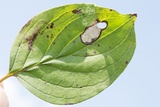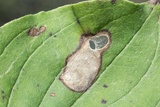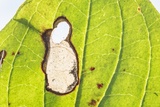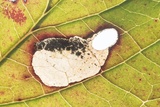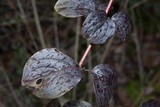Antispila petryi Martini, 1899 Species
Last modified: Dec. 16, 2025, 6 p.m.
This species was – initially based on DNA investigations – separated form Antispila treitschkiella in 2018. The latter is also a smaller species, shows some differences in larval and genitalic morphology and has another hostplant.
Details
- Classification
- Family: Heliozelidae > Genus: Antispila > Species: Antispila petryi
- Vernacular names
- Rode kornoeljegaatjesmaker (NL), Yellow-spot Lift (EN), Petrys Erzglanzfalter (DE)
- Status
-
Native
Distribution
Caterpillar
The translucent pale-grey caterpillar has a brown head. The mesonotum shows a black spot (missing in A. treitschkiella).
Mine
Initially, the mine is a narrow gallery along the leaf edge when the egg has been laid there but it is a wrinkled gallery when the egg was laid elsewhere in the leaf. The width of the frass line in the gallery is variable. Later on, the caterpillar constructs a full-depth bladder mine that often overruns the initial corridor gallery. The frass in the blotch mine is generally in a pile on one side of the mine, with some scattered grains.
See also bladmineerders.be
Bionomics
To deposit the egg, the female punctures a leaf at the underside, usually near its edge. The mine starts as a narrow gallery along the leaf edge when the egg has been laid there but as a wrinkled one when the egg was laid elsewhere in the leaf. The width of the frass line in the gallery is variable. Later on, the caterpillar constructs a full-depth bladder mine that often overruns the initial corridor gallery. The frass in the blotch mine is generally in a pile on one side of the mine, with some scattered grains. Eventually, the larva cuts a 4–5 mm long excision in which it crawls – or lowers itself – towards the soil. The caterpillar hibernates and subsequently pupates in the following spring.
Flight periods
Univoltine but no approximate flight period is known yet.
Observed on
- Host plant (species):
- Cornus sanguinea
The caterpillar is monophagous on Cornus sanguinea.
